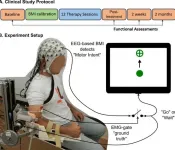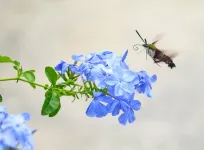(Press-News.org) A recent study finds that, in the wake of a mass shooting, National Rifle Association (NRA) employees, donors and volunteers had extremely mixed emotions about the organization - reporting higher levels of both positive and negative feelings about the NRA, as compared to people with no NRA affiliation.
"We wanted to see what effect 'in-group' affiliation and political identity had on how people responded to the NRA's actions after a mass shooting," says Yang Cheng, co-author of the study and an assistant professor of communication at North Carolina State University. "The political findings were predictable - Republicans thought more favorably of the NRA than Democrats did. But the in-group affiliation was a lot more complex than we anticipated.
"The people most critical of the NRA were the people most closely affiliated with it - but those were also the people most hopeful about the organization."
For this study, the researchers conducted an online survey of 603 U.S. adults. Given the nature of the study, it's important to understand the make-up of the study participants. Approximately 63% of the participants, or 378 people, were neither affiliated with the NRA nor supportive of it. The study also include 56 NRA employees, which made up 9% of the participants; 51 NRA members (8.5%); three NRA donors (0.5%); seven NRA volunteers (1.2%); and 108 people (17.9%) who were not NRA members, but who supported the organization. In terms of political affiliation, there were 274 Democrats (45.4%); 199 Republicans (33%); and 130 people who did not identify as Republicans or Democrats (21.6%). The survey was conducted in the wake of the 2018 shooting at Marjory Stoneman Douglas High School in Parkland, Florida.
The survey questions were designed to capture how study participants felt about the NRA's response to the Parkland shooting.
Broadly speaking, the findings were consistent with what one would expect. For example, people who said they support the NRA had more positive feelings about the NRA's actions than people who said they did not support the NRA. But there were some surprises.
For example, it's not surprising that NRA employees and donors reported having the most positive feelings towards the NRA's actions, such as hope. NRA volunteers were a close second.
But it is surprising that NRA employees, donors and volunteers also reported the highest negative emotions toward the NRA's actions after the Parkland shooting. Negative emotions, in this context, include fear, anger and disgust.
NRA donors and employees also reported the highest levels of "conflict judgment," meaning they felt the most strongly that the organization was not handling the crisis well. Examples of relevant questions from the survey include: "I don't like much of what the NRA did after the shooting" and "The NRA's actions after this shooting were harmful to me personally."
"Our findings suggest that in-group members, while supportive of the organization, are even more critical than out-group members," Cheng says. "That was not what we were anticipating, based on traditional social identity research."
On the other hand, Cheng notes that political partisanship did make a difference, with Democrats and Republicans taking clearly delineated stances toward the NRA.
"The finding raises some questions about how non-profit organizations need to think about crisis communications, at least in the context of gun control issues," Cheng says. "It also highlights the need for more issue-specific research, since there can clearly be significant deviations from what you would anticipate if you were looking only at the available literature."
INFORMATION:
The paper, "The NRA in Crisis: Social Identities and Publics' Cognitive and Affective Evaluations," is published in the International Journal of Business Communication. First author of the paper is Hongmei Shen of San Diego State University.
Stroke survivors who had ceased to benefit from conventional rehabilitation gained clinically significant arm movement and control by using an external robotic device powered by the patients' own brains.
The results of the clinical trial were described in the journal NeuroImage: Clinical.
Jose Luis Contreras-Vidal, director of the Non-Invasive Brain Machine Interface Systems Laboratory at the University of Houston, said testing showed most patients retained the benefits for at least two months after the therapy sessions ended, suggesting the potential for long-lasting gains. He is also Hugh Roy and Lillie Cranz Cullen Distinguished Professor of electrical and computer engineering.
The trial involved training stroke survivors with limited movement in one arm to use a brain-machine interface ...
GAINESVILLE, Fla. --- Entomologist Akito Kawahara's message is straightforward: We can't live without insects. They're in trouble. And there's something all of us can do to help.
Kawahara's research has primarily focused on answering fundamental questions about moth and butterfly evolution. But he's increasingly haunted by studies that sound the alarm about plummeting insect numbers and diversity.
Kawahara has witnessed the loss himself. As a child, he collected insects with his father every weekend, often traveling to a famous oak outside Tokyo ...
MANHATTAN, KANSAS -- Kyle Goerl, the medical director of Kansas State University's Lafene Health Center, is part of a collaborative team that is providing research-based guidance during the COVID-19 pandemic. The team's latest research contributed to the updated quarantine guidance from the Centers for Disease Control and Prevention.
Goerl is a co-author of the publication "Time from Start of Quarantine to SARS-CoV-2 Positive Test Among Quarantined College and University Athletes." The publication appeared in the Morbidity and Mortality Weekly Report from the CDC on Friday, Jan. 8, and involved researchers from multiple organizations and universities.
The publication was one of many that the ...
Osaka, Japan -- Ultra-intense lasers with ultra-short pulses and ultra-high energies are powerful tools for exploring unknowns in physics, cosmology, material science, etc. With the help of the famous technology "Chirped Pulse Amplification (CPA)" (2018 Nobel Prize in Physics), the current record has reached 10 Petawatts (or 10^16 Watts). In a study recently published in Scientific Reports, researchers from Osaka University proposed a concept for next-generation ultra-intense lasers with a simulated peak power up to the Exawatt class (1 Exawatt equals 1000 Petawatts).
The laser, which was invented by Dr. T. H. Maiman in 1960, has one important characteristic of high intensity (or high peak power for pulse lasers): historically, laser peak ...
Scientists at Nanyang Technological University, Singapore (NTU Singapore) have developed insulin nanoparticles that may one day become the basis for an oral medicine, and an alternative to insulin injections for diabetic patients.
In a pre-clinical study, the NTU Singapore team fed insulin-containing nanoparticles to rats and found that insulin increased in their blood minutes later.
Insulin therapy is often an important part of treatment for diabetes, a metabolic disease that affects 422 million people globally . In Singapore, the number of diabetics is expected to grow to 1 million - almost a fifth of the population - in 2050 .
Delivering insulin orally would be preferable over insulin jabs for patients because it causes less ...
Anthropogenic, or human-made, heat flux in the near-surface atmosphere has changed urban thermal environments. Much of this fluctuation has been noted with rapid development of the global economy and urbanization since the turn of the 21st century. Meanwhile, the number of extreme temperature events in the first decade of the 21st century grew faster than in the last 10 years of the 20th century. During this period, urban extreme heat events have become more frequent, breaking temperature records more often.
"We found the relationships between anthropogenic heat flux and extreme temperature events..." said Prof. Zhenghui Xie, a scientist with the Institute of Atmospheric Physics, Chinese Academy of Sciences. "...including ...
DALLAS - Jan. 12, 2021 - A team of UT Southwestern researchers has identified a gene involved in the growth of breast cancer, a finding that could lead to potential new targets for treatment.
"The gene ZMYND8 is increased in breast cancer conditions, and higher levels of the gene correlate with poor survival of breast cancer patients," says Yingfei Wang, Ph.D., assistant professor of pathology and neurology and corresponding author of the new study, published in Cancer Research. "It could be a promising target for antitumor immunotherapy."
In the U.S., about 1 in 8 women will develop breast cancer at some point in their life. Worldwide, breast cancer is the most common cancer ...
In a paper published in Molecular Frontiers Journal, researchers from Cambridge, Massachusetts and Bangalore, India study the effectiveness of FEND product to significantly improve airway hygiene by reducing and suppressing respiratory droplets potentially containing airborne pathogens and other contaminants. The study's findings further highlight why the FEND product is an important new daily hygiene protocol that joins century-old hand washing, masking and distancing measures as a fourth protective layer of defense against aerosolized particles.
The new study examined two nasal salines: ...
CORVALLIS, Ore. - A resemblance to moss, lichens and fungi made for fantastic cover by a new genus and species of cylindrical bark beetle described by an Oregon State University College of Science researcher.
"If you can't beat your enemies or run away, then hide, and that is what this Cretaceous beetle is doing," said OSU's George Poinar Jr. "He is hiding under a spectacular camouflage of his own making, allowing him to blend into a mossy background."
Poinar, an international expert in using plant and animal life forms preserved in amber to learn more about the biology and ecology of the distant past, and collaborator Fernando ...
Research on cycad trees in Colombia, Guam, and the Philippines has illuminated how knowledge of their branching behavior may benefit conservation decisions for the endangered plants. In a study published in the December issue of the journal Horticulturae, scientists from the University of Guam and the Montgomery Botanical Center in Florida show that the number of times a cycad tree produces a branch can be used to infer the sex of the tree. The findings have practical applications for use of the sexual dimorphism that is described.
Cycads are unique seed-producing plants. Conservation actions are being implemented for many species around the world as cycads are being threatened by human activity.
The arborescent cycad stem is constructed using ...








